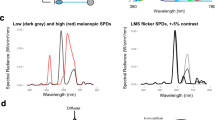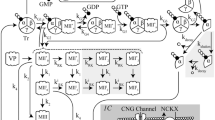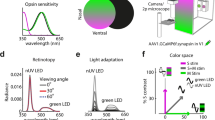Abstract
The rod visual system in its dark-adapted state behaves as a near-ideal light detector1. Psychophysical studies on the reliability of light detection in man2,3, analysis of the dark noise in rod bipolar cells4 and observation of photon-like events in rods5 in the dark suggest that the visual pigment, rhodopsin, is very stable against spontaneous isomerization. When a light which bleaches a small fraction of the rhodopsin is extinguished, the visual threshold may be increased by several orders of magnitude. The eye is then ‘light-adapted’ and the process (or processes) by which the sensitivity returns constitutes dark adaptation. We report here that bleaching of a small fraction of the rhodopsin produces a prolonged increase in the noise observed in the dark in rod bipolar cells of the dogfish retina. The associated noise events are similar to those produced by the absorption of light quanta and presumably have their origin in the rods which transmit their signals to the bipolar cells. This increased noise after bleaching would decrease the reliability of detection of light quanta and contribute to the elevation of visual threshold.
This is a preview of subscription content, access via your institution
Access options
Subscribe to this journal
Receive 51 print issues and online access
$199.00 per year
only $3.90 per issue
Buy this article
- Purchase on Springer Link
- Instant access to full article PDF
Prices may be subject to local taxes which are calculated during checkout
Similar content being viewed by others
References
Hecht, S., Shlaer, S. & Pirenne, M. H. J. gen. Physiol. 25, 819–840 (1942).
Denton, E. J. & Pirenne, M. H. J. Physiol. Land. 123, 417–442 (1954).
Barlow, H. B. J. opt. Soc. Am. 46, 634–639 (1956).
Ashmore, J. F. & Falk, G. Nature 270, 69–71 (1977).
Yau, K.-W., Lamb, T. D., Matthews, G. & Baylor, D. A. Vision Res. 19, 387–390 (1979).
Ashmore, J. F. & Falk, G. Nature 263, 248–249 (1976).
Ashmore, J. F. & Falk, G. J. Physiol., Lond. 300, 115–150 (1980).
Lamb, T. D. Nature 287, 349–351 (1980).
Dowling, J. E. & Ripps, H. J. gen. Physiol. 56, 491–520 (1970).
Rushton, W. A. H. J. opt. Soc. Am. 54, 104–109 (1963).
Barlow, H. B. Vision Res. 4, 47–58 (1964).
Rushton, W. A. H. & Powell, D. S. Vision Res. 12, 1073–1081 (1972).
Pugh, E. N. J. Physiol., Lond. 248, 413–432 (1975).
Fein, A. & Hanani, M. Brain Res. 156, 157–161 (1978).
Tsukahara, Y. & Horridge, G. A. J. exp. Biol. 68, 137–149 (1977).
Author information
Authors and Affiliations
Rights and permissions
About this article
Cite this article
Ashmore, J., Falk, G. Photon-like signals following weak rhodopsin bleaches. Nature 289, 489–491 (1981). https://doi.org/10.1038/289489a0
Received:
Accepted:
Issue Date:
DOI: https://doi.org/10.1038/289489a0
Comments
By submitting a comment you agree to abide by our Terms and Community Guidelines. If you find something abusive or that does not comply with our terms or guidelines please flag it as inappropriate.



